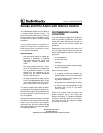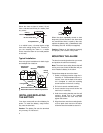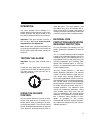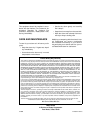
3
OPERATION
The alarm operates once a battery is in-
stalled. When it senses smoke or other com-
bustion products, the alarm sounds a loud
tone which continues until the air is cleared.
Important:
If the alarm sounds, check for a
fire. If a fire is discovered,
leave the build-
ing and call the fire department.
Note:
Smoke from household activities such
as cooking and smoking will not normally set
off the alarm unless that smoke is blown di-
rectly at it.
TESTING THE ALARM
Important:
Test your alarm at least once a
week.
To test the alarm, hold down the test button
on the front of the alarm for about 2 seconds.
The alarm sounds a loud tone until you re-
lease the test button.
USING THE SILENCE
CONTROL
You can set the alarm so it sounds a lower-
volume tone when there is smoke from a
known source (such as cooking) in the area,
to reduce false alarms. To turn on the silence
control, hold down the test button on the front
of the alarm for at least 6 seconds, then re-
lease the button. The alarm sounds a soft
tone about every 30 to 40 seconds and re-
duces its sensitivity to smoke. After about 8
minutes, the alarm automatically resets itself
to sound a loud tone when it detects smoke.
NATIONAL FIRE
PROTECTION ASSOCIATION
REQUIRED PROTECTION
For your information, the National Fire Pro-
tection Association’s Standard 72 reads as
follows:
“2-2.1.1.1 Smoke detectors shall be installed
outside of each separate sleeping area in the
immediate vicinity of the bedrooms and on
each additional story of the family living unit
including basements and excluding crawl
spaces and unfinished attics. In new con-
struction, a smoke detector shall be installed
in each sleeping room.”
“A-2.5.2.1 Smoke Detection — Are More
Smoke Detectors Desirable? The required
number of smoke detectors might not pro-
vide reliable early warning protection for
those areas separated by a door from the ar-
eas protected by the required smoke detec-
tors. For this reason, it is recommended that
the householder consider the use of addition-
al smoke detectors for those areas for in-
creased protection. The additional areas
include the basement, bedrooms, dining
room, furnace room, utility room, and hall-
ways not protected by the required smoke
detectors. The installation of smoke detec-
tors in kitchens, attics (finished or unfin-
ished), or garages is not normally
recommended, as these locations occasion-
ally experience conditions that can result in
improper operation.”
D
O
N
O
T
P
A
I
N
T
Test Button






